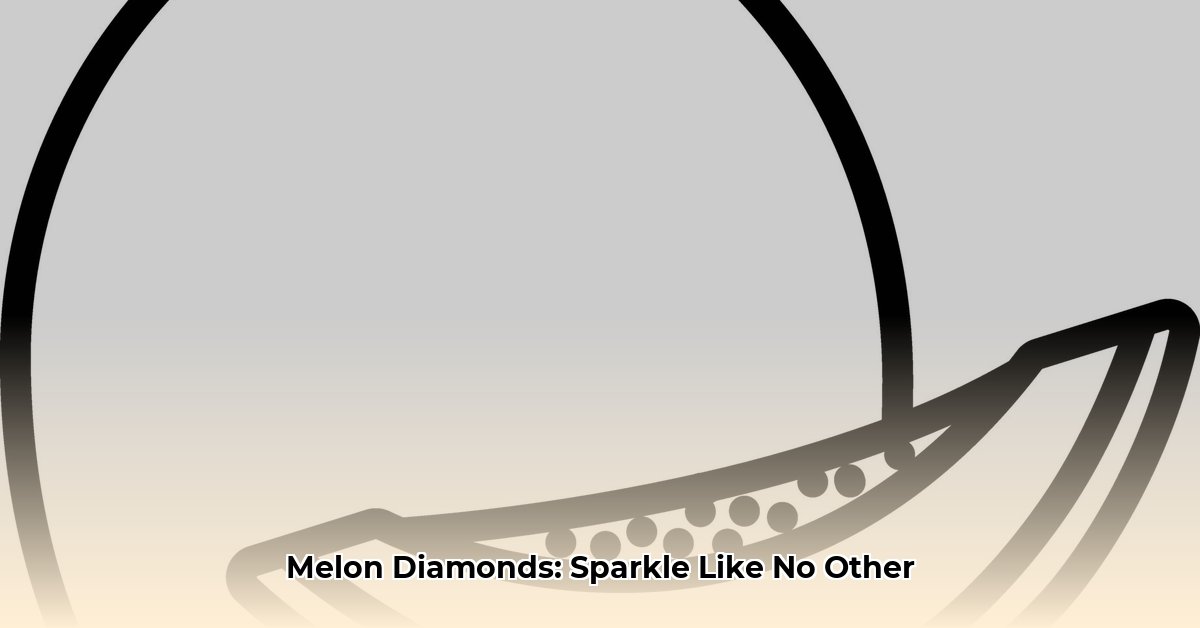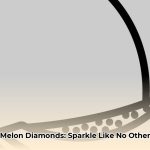Beyond the sparkle of traditional diamonds lies a hidden gem: the melon cut diamond. With its vintage allure and unique brilliance, this cut offers a captivating alternative to more conventional choices. This guide unveils the secrets of the melon cut, exploring its history, craftsmanship, and distinctive qualities.
Discovering the Melon Cut
The melon cut diamond, sometimes called the cucurbit cut, distinguishes itself through soft, rounded contours, reminiscent of its namesake fruit. Unlike brilliant cuts with their dazzling facets, the melon cut possesses a smooth, curved surface. This gives it a subtle, almost velvety luster, evoking a sense of understated elegance. Its lack of traditional table, crown, and pavilion facets further enhances its unique character. Variations exist, such as cushion, elongated, and rose-cut melon diamonds, each offering a nuanced take on this distinctive style.
A History of Subtle Brilliance
The melon cut’s history is shrouded in a certain mystique. While pinpointing its exact origins proves challenging, evidence suggests it likely emerged during the late Victorian and Edwardian eras (late 19th and early 20th centuries), a time when jewelry design often drew inspiration from nature. Its resurgence in contemporary jewelry speaks to the enduring appeal of vintage aesthetics and the desire for unique, historically-infused pieces.
The Art of Melon Cut Craftsmanship
Creating a melon cut diamond is a testament to an artisan’s skill. The process begins with selecting a high-quality rough diamond, prioritizing clarity. Inclusions, more readily visible in melon cuts, influence this choice. Then, the meticulous shaping and faceting begin. Each curve is painstakingly carved, requiring precision and a keen eye. This intensive hand-craftsmanship contributes significantly to the melon cut’s value and its relative rarity.
Melon Cut vs. Brilliant Cut: A Comparison
| Feature | Melon Cut | Brilliant Cut |
|---|---|---|
| Brilliance | Subdued, soft glow | Intense, fiery sparkle |
| Fire | Subtle shimmer | Significant, rainbow flashes |
| Shape | Rounded, curved | Geometric, precise |
| Overall Look | Vintage, unique | Modern, classic |
Advantages and Disadvantages of the Melon Cut
Pros:
- Individuality: The melon cut offers a distinctive look, setting it apart from more common diamond cuts.
- Vintage Allure: Its historical connections imbue it with a timeless elegance, appealing to those who appreciate antique and vintage styles.
- Subtle Radiance: The soft, diffused glow provides a sophisticated alternative to the often-overpowering brilliance of other cuts.
Cons:
- Less Sparkle: While beautiful, the melon cut may not exhibit the same dazzling brilliance as a brilliant cut. This characteristic is a matter of personal preference.
- Limited Availability: Its relative rarity and the specialized craftsmanship involved may require more effort in sourcing a melon cut diamond.
- Inclusion Visibility: The nature of the cut can sometimes make inclusions more apparent, emphasizing the importance of clarity grading.
Melon Cut Diamonds in Jewelry
The melon cut’s versatility shines through in various jewelry applications. It can take center stage in a vintage-inspired engagement ring, add a touch of understated elegance to earrings, or create a captivating pendant. Its soft brilliance complements both classic and contemporary designs.
Value and Appraisal: Factors Influencing Price
The 4Cs—Cut, Color, Clarity, and Carat weight—influence a melon cut diamond’s value, as with any diamond. However, rarity and craftsmanship play a significant role, potentially increasing its price. Consulting a qualified gemologist is crucial for accurate appraisal, especially given the melon cut’s unique characteristics. Ongoing research may reveal new insights into diamond properties and consequently affect valuation approaches.
Caring for Your Melon Cut Diamond
Preserving the beauty of a melon cut diamond requires gentle care. Regular cleaning with warm water, mild dish soap, and a soft brush suffices. Avoid harsh chemicals and ultrasonic cleaners, as these can damage the delicate surface. Storing it separately from other jewelry prevents scratches and maintains its pristine condition.
Finding a Melon Cut Diamond
Locating a melon cut diamond often involves seeking out specialized jewelers who appreciate its unique qualities. Estate sales and antique markets can also be fruitful hunting grounds. A reputable gemologist can be an invaluable resource in verifying authenticity and assessing quality.
Ongoing Research and Future Considerations
Research into diamond cutting and evaluation is an ongoing process. New techniques and findings continually emerge, potentially reshaping our understanding of cuts like the melon cut. Some experts suggest that its rarity and vintage appeal could lead to increased collector interest and value appreciation in the future. Staying informed about these developments can be beneficial for both enthusiasts and investors.
- Memorial Stones for Gardens: A Guide to Creating a Lasting Tribute - April 29, 2025
- Melon Cut Diamonds: A Comprehensive Guide - April 29, 2025
- MarketStreet Lynnfield Stores: A Complete Directory & Shopping Guide - April 29, 2025










